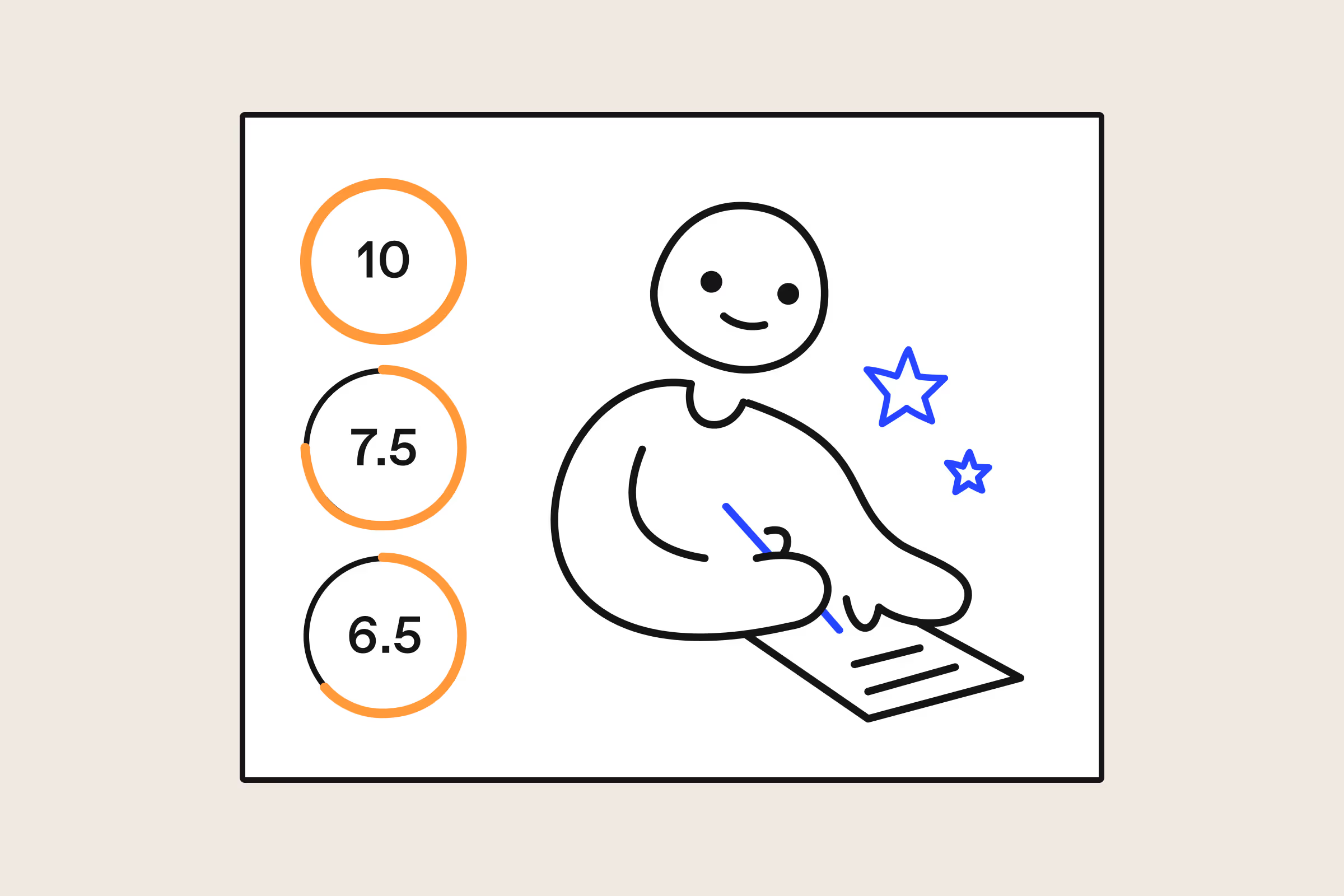5 Free employee engagement survey templates

Discover Workleap Officevibe's benchmark report on 12 key employee engagement metrics

It’s easy to talk in the abstract about keeping your employees engaged. But how do you, as a manager, put this into practice, especially if you’re short on time? Surveys are a great way to quickly get the pulse on your team’s engagement levels. And an employee engagement survey template is a fantastic time saver to help you prepare.
A manager’s role is never static because team dynamics are always evolving. Your team’s needs and challenges change from week to week, month to month, and year to year. With the right surveys, you can stay nimble to better understand your team and give them the support they deserve.
Ready to start? Select a free employee engagement survey template based on your team’s needs, or build your own with our practical how-to steps.
The importance of measuring employee engagement
But first, what are employee engagement surveys?
Employee engagement surveys, sometimes coined pulse surveys when sent frequently, feature a series of questions specifically designed to measure employee engagement metrics, including:
- Alignment
- Employee satisfaction
- Ambassadorship
- Happiness and wellness
- Relationships with managers and peers
Managers should constantly think about ways to keep their employees engaged. And while that statement seems obvious, it's often forgotten about or deprioritized on managers' long to-do lists. What many may not realize is that by letting engagement fall behind, they're missing out on serious benefits.
These employee engagement benefits include happier team members that perform better at work. In fact, an employee’s job satisfaction and quality of work influence each other, and the key to improving both is employee engagement.
Why it's key to measure employee engagement
It can be difficult (and time-consuming if you don't know where to start) to get a sense of how motivated each employee feels at any given time. A better approach is to look for common trends among team members when employee engagement is either riding high or crashing.
Measuring employee engagement with surveys can help you spot these engagement swings, so you can act fast and implement an effective employee engagement action plan.
Here are a few common scenarios when measuring employee engagement can help:
- When your team excels in a certain area and engagement is high, you can tap into that energy with new projects or by offering your team extra opportunities to shine.
- When the data shows that people are struggling in certain areas and engagement levels are low, you can nip those problems in the bud with extrinsic motivators like perks or fun events.
- When the reality of your team shifts, people leave, or new employees onboard, you can spot how and where it’s impacting your team and support them in those areas.
- When the year comes to an end, you can use your employee engagement survey results to compare past performance outcomes with engagement levels.
Pro tip: A growing team needs you to teach them how to collaborate with new coworkers and a more complex team structure. Sometimes your team is under a lot of pressure, or temporarily lacking in direction. You need to be ready to adapt to the situation and pitch in as a team player to help everyone do their best work together.
5 free employee engagement survey templates
There are countless employee engagement survey questions you can use, but we've taken the liberty of outlining the most common ones you need to get started. Select one of our employee engagement survey templates below, depending on your current needs and where your team stands.
How to format the templates
Each survey question is written to fit an ‘opinion scale’ format, where employees can gauge their answer on a scale from ‘strongly agree’ to ‘strongly disagree’. Depending on what employee survey tool you’re using, you could use a sliding scale or multiple-choice survey question option.
If you use multiple-choice, give 5 answer options: strongly agree, somewhat agree, neutral, somewhat disagree, and strongly disagree. With Officevibe's employee engagement solution, you can create an opinion scale, multiple-choice, or text engagement survey questions when you build a custom survey.
1. Employee engagement survey template for large teams
In a larger team setting, it’s more challenging for managers to stay aware of everyone’s engagement levels. So, this survey template is your best tool to make sure your team is functioning well.
- Do you look forward to starting your workdays?
- Are you confident in voicing your opinion in such a big team?
- Do you believe your input will be taken seriously in a large team?
- Is there good transparency on your team in how decisions get made?
- Can you talk to your manager or senior leadership when you need to?
- Do you have the space and autonomy you need to do your work?
- Can you see how your contributions help your company’s goals?
- Do you feel seen and appreciated by your colleagues?
- Are you provided with all the tools and resources you need to do a great job?
2. Employee engagement survey template for small teams
With smaller teams, managers may think it’s easier to stay on top of how everyone feels. But giving these fast, light surveys is an effective way to spot anything you might be missing.
- Do you have the right amount of work and responsibilities?
- Would you tell people this is a good place to work?
- Can you envision great things for yourself and your team in the future?
- Does your team work well without too many lengthy meetings?
- Do you have the flexibility to experiment with your work?
- Do you fully understand the company’s mission and vision?
- Are you happy when you arrive at work each day?
- Are you impressed with the quality of your team members' work?
- When something unexpected comes up, is it clear whose task it is?
- Does the team have the knowledge, expertise, and human power needed to succeed?
3. Monthly employee engagement survey template
Things change in the workplace monthly based on many factors: priorities, relationships with colleagues, and employee productivity. A great manager can use a monthly engagement survey to keep on top of moving trends by asking questions like:
- Do you enjoy the work you do?
- Have you received some sort of praise this month?
- Were there any problems last month that were not resolved?
- Do you understand your role and upcoming tasks clearly?
- Are you proud of the work you’ve been doing?
- Does your manager show you trust and respect?
- Does the company promote a positive workplace culture?
- Have you learned something new on the job this month?
- Is the number of tasks you currently have a good amount?
4. Yearly employee satisfaction survey template
At the annual level, your data can reveal some real high-level issues, like major swings in employee engagement and team alignment. Knowing how things stand is key to making big plans regarding projects or setting long-term goals with your employees. But these crucial high-level assessments cannot be the only surveys you give. Without more granular surveys throughout the year, your data from annual surveys will likely be biased. Some questions
- Do you feel good about your work at the company?
- Would you refer a friend to work here?
- Do you want more challenges and responsibilities in the coming year?
- Is your compensation package fair?
- Are you satisfied with your benefits package?
- Does this company care about your work-life balance and well-being?
- Does your supervisor know you as an individual?
- Are you happy working with your colleagues?
- Are you learning new skills and/or improving your current ones?
- Can you see how your work has contributed to the team and company’s success?
If you're looking for deeper insights into more specific topics, check out these other employee satisfaction survey questions.
5. Survey template for disengaged employees
There are many reasons why individuals or your team may be disengaged at work. Understanding overlapping themes and sentiments on your team can help you tackle any major issues before you dive into one-on-one problem-solving. Surveys like this help you navigate that tricky terrain.
- Does your manager inspire you to do great work?
- Do you feel you owe it to your team to give your best?
- Are you eager to clock out every day, or at the end of the week?
- Do you understand how your role fits into the big picture?
- Are you getting enough recognition at work for your efforts?
- Do you wish you had other tasks or another role?
- Can you picture yourself working here next year?
- Are you regularly overwhelmed by your workload?
- Do you feel your job is too easy?
- Do you think your salary is fair or your level of experience?
[ov_cta id="5117519"]
Setting up and conducting your employee engagement surveys
You don’t want your surveys to take too much time or be too frequent as you run the risk of overwhelming your team and reducing their participation. Then again, if these surveys pop up too infrequently, you won’t be getting the most accurate and up-to-date data. So it’s important to strike the right balance.
Best practices for conducting employee engagement surveys
We've been in the business long enough to know what works and work doesn't, and here are the main best practices we've gathered over time:
- Questions: The sweet spot for a regular pulse survey is five questions, but if you need more insights on a given week or month, feel free to include up to 10 questions. Remember that the longer you make your surveys, the more you risk your response rate dipping.
- Duration: A good employee engagement survey should give you all the information you need with just a few questions, and it should never feel tedious for an employee to fill out. We recommend keeping the duration between three to five minutes long.
- Frequency: The point of an engagement survey is to get a real-time pulse on your team and make sure your employees feel heard regularly. You should therefore aim to send your surveys out every week or at least bi-weekly.
- Anonymity: Our rule of thumb is that surveys should always remain anonymous. This gives employees a chance to be 100% honest without any fear of judgment or repercussions.
💡 Learn more about employee engagement survey best practices.
How to build your own employee engagement survey
If none of the above employee engagement survey questions meet your specific needs, don’t sweat it. Build your own with these key tips.
- Assess your baseline. First, you may want to have an informal chat with your team to understand how things are. This will pinpoint areas to probe in the survey.
- Set objectives. Employee engagement can cover many metrics, like job satisfaction, relationship with peers, or alignment with company goals. Figure out what you aim to uncover and plan your questions accordingly.
- Choose your words. When you plan and select your questions, clarity, and simplicity are key, and neutral tones are best. You also need to make sure you address the points laid out in your objectives.
Equip yourself with the right survey tools
There are many engagement survey methods out there today. Some are manual (sending an email or Slack message with a few questions), some are automated (having a pulse survey platform), and others are somewhere in between (using survey tools like Survey Monkey or Google Forms). Your plate is probably already super full, so if you want a more hands-off approach, using an employee engagement survey tool is the way to go.
Employee pulse surveys
Having technology on your side makes the process of surveying employees a regular occurrence, without adding to your workload. Automated pulse survey tools choose from a curated list of employee engagement survey questions, separated by engagement metrics and submetrics, and send short surveys according to your preferred cadence.
Officevibe makes it easy (almost, fun?) to create surveys, analyze survey results, and even give your team a space to give anonymous feedback. Plus, our bank of in-app survey templates helps you dig deeper into specific topics, no planning needed.
Custom employee surveys
An engagement platform like Officevibe, for example, also gives you the option to set up custom employee surveys so that you can:
- Be in control of your surveys whenever necessary.
- Collect insights on topics specific to your organization or team.
- Follow up on a conversation with a unique survey.
Once filled out, the software gathers qualitative and quantitative data submitted by employees and reports on the findings for you. Not only do these tools give you a clear snapshot of how your team feels at a given moment, but they also help you keep track of any changes over time.
⭐️ Learn to read your team like a pro with this complete guide on employee engagement surveys.
Drive action from your engagement survey results
All employee feedback and data mean nothing if you don’t act on them. These free employee engagement survey templates are a great starting point as you build your employee engagement strategy, but it's important not to stop there.
Be sure to leverage the actionable insights you receive and focus your attention where it matters most to best support your team.
Give HR and managers the clarity, confidence, and connection to lead better every day.


%20(1).avif)


.avif)
.avif)

.avif)






